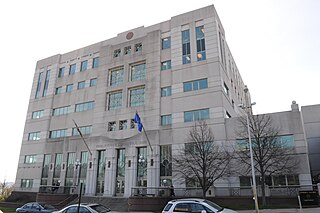Related Research Articles

The United States Census Bureau (USCB), officially the Bureau of the Census, is a principal agency of the U.S. Federal Statistical System, responsible for producing data about the American people and economy. The Census Bureau is part of the U.S. Department of Commerce and its director is appointed by the President of the United States.

Aleutians West Census Area is a census area located in the U.S. state of Alaska. As of the 2020 census, the population was 5,232, down from 5,561 in 2010.

Litchfield County is in northwestern Connecticut, United States. As of the 2020 census, the population was 185,186. The county was named after Lichfield, in England. Litchfield County has the lowest population density of any county in Connecticut and is the state's largest county by area.

Middlesex County is a county in the south central part of the U.S. state of Connecticut. As of the 2020 census, the population was 164,245. The county was created in May 1785 from portions of Hartford County and New London County.

New London County is in the southeastern corner of Connecticut and comprises the Norwich-New London, Connecticut Metropolitan Statistical Area, which is also included in the Hartford-East Hartford, Connecticut Combined Statistical Area. There is no county government and no county seat, as is the case with all eight of Connecticut's counties; towns are responsible for all local government activities, including fire and rescue, snow removal, and schools.

Tolland County is a county in the northeastern part of the U.S. state of Connecticut. As of the 2020 census, its population was 149,788. It is incorporated into 13 towns and was originally formed on 13 October 1785 from portions of eastern Hartford County and western Windham County.

Ritchie County is a county in the U.S. state of West Virginia. As of the 2020 census, the population was 8,444. Its county seat is Harrisville. The county was created in 1843 by the Virginia General Assembly and named for Richmond newspaper publisher Thomas Ritchie.

Giles County is a county located in the U.S. state of Virginia on the West Virginia state line. As of the 2020 census, the population was 16,787. Its county seat is Pearisburg.

Warren County is a county located in the U.S. state of Mississippi. Its western border is formed by the Mississippi River. As of the 2020 census, the population was 44,722. Its county seat is Vicksburg. Established by legislative act of December 22, 1809, Warren County is named for American Revolutionary War officer Joseph Warren.
Race and ethnicity in the United States census, defined by the federal Office of Management and Budget (OMB) and the United States Census Bureau, are the self-identified categories of race or races and ethnicity chosen by residents, with which they most closely identify. Residents can indicate their origins alongside their race, and are asked specifically whether they are of Hispanic or Latino origin in a separate question.

The 2000 United States census, conducted by the Census Bureau, determined the resident population of the United States on April 1, 2000, to be 281,421,906, an increase of 13.2 percent over the 248,709,873 people enumerated during the 1990 census. This was the twenty-second federal census and was at the time the largest civilly administered peacetime effort in the United States.

The United States census is a census that is legally mandated by the Constitution of the United States. It takes place every ten years. The first census after the American Revolution was taken in 1790 under Secretary of State Thomas Jefferson. There have been 23 federal censuses since that time. The census includes Territories of the United States. The United States Census Bureau is responsible for conducting the census.

The American Community Survey (ACS) is an annual demographics survey program conducted by the U.S. Census Bureau. It regularly gathers information previously contained only in the long form of the decennial census, including ancestry, citizenship, educational attainment, income, language proficiency, migration, disability, employment, and housing characteristics. These data are used by many public-sector, private-sector, and not-for-profit stakeholders to allocate funding, track shifting demographics, plan for emergencies, and learn about local communities. Sent to approximately 295,000 addresses monthly, it is the largest household survey that the Census Bureau administers.

The 1850 United States census was the seventh decennial United States Census Conducted by the Census Office, it determined the resident population of the United States to be 23,191,876—an increase of 35.9 percent over the 17,069,453 persons enumerated during the 1840 census. The total population included 3,204,313 slaves.

The 1980 United States census, conducted by the Census Bureau, determined the resident population of the United States to be 226,545,805, an increase of 11.4% over the 203,184,772 persons enumerated during the 1970 census. It was the first census in which a state—California—recorded a population of 20 million people, as well as the first in which all states recorded populations of over 400,000.

The 1920 United States census, conducted by the Census Bureau during one month from January 5, 1920, determined the resident population of the United States to be 106,021,537, an increase of 15.0 percent over the 92,228,496 persons enumerated during the 1910 census.

The 1940 United States census, conducted by the Census Bureau, determined the resident population of the United States to be 132,164,569, an increase of 7.6 percent over the 1930 population of 122,775,046 people. The census date of record was April 1, 1940.

The 1970 United States census, conducted by the Census Bureau, determined the resident population of the United States to be 203,392,031, an increase of 13.4 percent over the 179,323,175 persons enumerated during the 1960 census.
Dallas is the ninth-most populous city in the U.S. and third in Texas after Houston and San Antonio. At the 2010 U.S. census, Dallas had a population of 1,197,816. In July 2018, the population estimate of the city of Dallas was 1,345,076, an increase of 147,260 since the 2010 United States Census.
The demographics of Virginia are the various elements used to describe the population of the Commonwealth of Virginia and are studied by various government and non-government organizations. Virginia is the 12th-most populous state in the United States with over 8 million residents and is the 35th largest in area.
References
- ↑ "2010 Public Use Microdata Areas (PUMAs) and Characteristics of Microdata" (PDF). U.S. Census Bureau. Retrieved 23 October 2013.
- ↑ "2020 PUMA Names File" (PDF). census.gov. United States Census Bureau . Retrieved 3 November 2023.